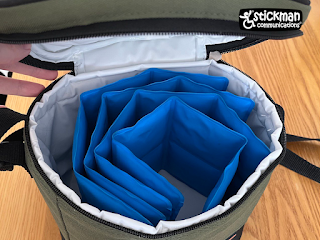
I've used cooling vests for over 10 years now, and absolutely love them. They mean I can function a lot better for a few hours a day in the summer - even if I am out and about.
It's basically a vest with 4 pouches on the inside, into which you put cooling packs. These packs contain a special 'phase change' cooling liquid. This liquid in the cool packs solidifies ('freezes') at a 15 degrees C - and stays at that temperature until it's all melted - which seems to be between 1 and 2.5 hours.
You can also get 21 degrees ones, which will melt a bit slower. I chose a shorter time of much better functioning instead of a slightly longer period of slightly better functioning (even 21 degrees can be borderline for my heat tolerance - but for some people 21 degrees might be better. Especially if you also have cold intolerance!
- 8 cells shape better to my body - creating a fairly even pressure, and cool hug on my torso. (Sensory issues mean this is a big deal for me!)
- Being a narrow build the 4 cell ones stick out a bit far at the top when I sit down, and annoy me. (This probably isn't an issue for slightly broader people)
- The greater flexibility of the 8 cell ones mean they can curve round to fit in a standard lunchbox coolbag - so I can easily carry a spare set with me - recharged and ready to go.
Bertschat:
EZcooldown:
- They can be recharged in fridge, freezer, icebucket. (In winter I sometimes use them when in places with the central heating set too high - and then I can recharge them by putting them outside! The colder the place, the quicker the recharge.
- They recharge best if they aren't stacked up - if stacked up the middles may not re-freeze because the surrounding packs insulate them from the cold air.
- Always lay them flat to recharge them - otherwise you end up with wonky packs that can be very uncomfortable to wear!
- For smaller wearers like me who also self propel a wheelchair, the packs can stick out a bit - catching slightly on the top of the arms when pushing. Just enough to annoy me. Wearing a top that has sleeves that cover the top of the arm mean it protects the skin and stops it rubbing.

This T-shirt is probably the minimum sleeve that I can wear with a cooling vest. - I have flown internationally wearing a cooling vest multiple times. I always carry with me a GP letter saying I need my cooling vest to help me regulate my temperature, and the instructions /infosheet for the coolvest - just in case it's needed. At the hand baggage check I usually get pulled aside for having coolbags full of 'liquids' - most of the time they've just had a quick look at them then accepted them as medical kit and let me through. The only time someone kicked up a fuss I explained that they were medically necessary and asked to speak to their supervisor - who quickly agreed they were fine. (I'd recommend using airport assistance as that means the people checking hand luggage see that you are with assisted travel and therefore are more mentally prepared for you to have some different needs.)
- Make sure you have several layers between your boobs and the cooling vest...It's COLD. Putting it on and then remembering that you aren't wearing a bra is NOT pleasant!
- If you are googling to find a cooling vest like these, use 'phase change cooling vest'.


Comments
Post a Comment
Feel free to comment, but please note that any offensive or inappropriate comments - including advertising - will be moderated.